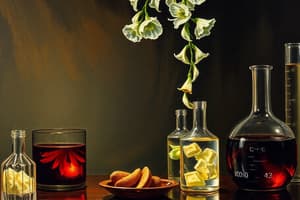Podcast
Questions and Answers
Which of the following correctly identifies a characteristic of chemical reactions?
Which of the following correctly identifies a characteristic of chemical reactions?
- They involve changes in the composition of substances. (correct)
- They only change the physical appearance of substances.
- They can be reversed at any time.
- They always require a catalyst to occur.
Which of these is NOT a typical example of a chemical reaction?
Which of these is NOT a typical example of a chemical reaction?
- Combustion of wood.
- Rusting of metal.
- Melting of ice. (correct)
- Milk curdling.
Which of the following is a sign that a chemical reaction has occurred?
Which of the following is a sign that a chemical reaction has occurred?
- The temperature remains constant.
- A change in state from liquid to solid.
- A color change in the mixture. (correct)
- Simple mixing of two liquids.
What is produced in the reaction $2Mg + O_{2} \rightarrow 2MgO$?
What is produced in the reaction $2Mg + O_{2} \rightarrow 2MgO$?
Which statement about physical changes is true?
Which statement about physical changes is true?
Flashcards
Chemical Reaction
Chemical Reaction
A change in the composition of substances, altering their chemical properties. Examples include rusting and combustion.
Physical Change
Physical Change
A change that only affects the physical properties of a substance, without altering its chemical composition. Examples include melting ice and freezing water.
Chemical Reaction Indicator
Chemical Reaction Indicator
A visual clue that a chemical reaction has occurred. Examples include a change in color, the release of heat or light, the formation of a gas, or the formation of a precipitate.
Reactants
Reactants
Signup and view all the flashcards
Products
Products
Signup and view all the flashcards
Study Notes
Chemical Reactions and Equations
- Chemical reactions involve changes in the composition and properties of substances.
- Physical changes only alter state or form, not composition.
- Examples of physical changes: melting ice, boiling water, evaporating water.
- Examples of chemical changes: milk souring, rusting of iron, combustion, synthesis, nuclear explosions.
- Chemical reactions are represented by chemical equations.
- These equations show reactants, products, and the relative amounts of each.
- Key types of chemical reactions include: combination, decomposition, displacement, exothermic, oxidation.
- Consider the reaction of magnesium with oxygen:
- 2Mg + O₂ → 2MgO
- Reactants: Magnesium and oxygen
- Product: Magnesium oxide
- Chemical reactions involve a rearrangement of atoms.
- Different observations can indicate a chemical reaction including colour change, formation of precipitate, gas evolution, temperature change.
Studying That Suits You
Use AI to generate personalized quizzes and flashcards to suit your learning preferences.
Description
Test your knowledge on chemical reactions and equations with this informative quiz. Explore the differences between physical and chemical changes, understand types of chemical reactions, and learn how to represent them using equations. Challenge yourself to identify reactants and products through various examples.




